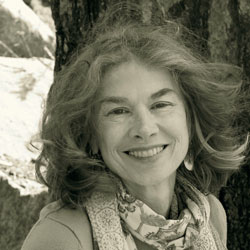Rublev, the great painter of icons,
is buried under one of his own churches;
infinity stretches in all directions. Under
the bricks, he hears the carriages move.
Visitors from countries stand in the square;
below their feet, the demons pass
back & forth between the worlds . . .
The icon watches as they are struck dumb
by the brown facility of paint.
Color has lost its innocence.
Russia is an enormous plain
over which wild energy rides.
Christ looks sickly & helpful,
raising two fingers. His eyes have apostrophes,
cloves of garlic. An artist is never your enemy.
How to interpret the painting through
circles of violence that made it. It moves
much more slowly than you do;
it always has something to conceal.
A painting shows you how to breathe.
History is still: it’s the wood horse
burning on its side. A dome
sacrifices itself to a bell; its ringing
swells & falls, a maybe yes
& maybe no that follows you-
Notes on the Poem
Really, it's just a coincidence that we seem to keep selecting Poems of the Week that discuss or use painting as their inspiration, as again does Brenda Hillman's "Very Far Back in This Life". We're not alone in noticing the pattern of profound connections between poetry and painting - reflections and examinations abound here, for example. Hillman takes as the painterly impulse sparking her poem the work of Andrei Rublev, a Russian Medieval artist renowned for his refined and exquisitely rendered religious iconography. She begins by establishing the enduring, centuries-long reverence with which Rublev's work is held. From there, as the poem wends its way down the page (the gentle wave of line indents rolling the reader along), it provides guideposts to how one can interpret and have a relationship with a painting. A reassurance is offered: "An artist is never your enemy." Interestingly, the poem becomes a kind of roadmap - circling back in on itself, somewhat ironically but also comfortingly - to how one can relate to any form of art. "A painting shows you how to breathe." Because breathing is an automatic, not conscious process, perhaps what we're being told is that our reaction to art can and should be as instinctual and is certainly as vital.
